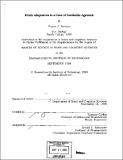| dc.contributor.advisor | Suzanne Corkin. | en_US |
| dc.contributor.author | Rendon, Regina A | en_US |
| dc.date.accessioned | 2010-01-07T20:48:14Z | |
| dc.date.available | 2010-01-07T20:48:14Z | |
| dc.date.copyright | 1998 | en_US |
| dc.date.issued | 1998 | en_US |
| dc.identifier.uri | http://hdl.handle.net/1721.1/50517 | |
| dc.description | Thesis (S.M.)--Massachusetts Institute of Technology, Dept. of Brain and Cognitive Sciences, 1998. | en_US |
| dc.description | Includes bibliographical references (p. 19-20). | en_US |
| dc.description.abstract | Normal subjects adapt quickly to the displacing effects of prism goggles. A measure of this adaptation comes from the negative aftereffects in reaching that subjects show after the prism goggles are removed. Neural circuitry within the cerebellar cortex has been implicated as the site of plasticity for visuomotor adaptation. An opportunity to test a 15-year-old boy, A.C., with near complete cerebellar agenesis allowed us to determine whether cerebellar structures are critical for prism adaptation to occur. A.C. was tested on two separate occasions, twice using his left hand, and once using his right hand. He wore prism goggles while pointing to a vertical line at each of nine target locations in baseline, exposure, and postexposure conditions. The position of his finger was recorded after each response. In the exposure condition, the goggles were adjusted to 11" displacement to the right when A.C. pointed with his left hand, and to the left when he pointed with his right hand. He received visual feedback only in the exposure condition. His results were compared to those of 20 normal control subjects (NCS). Independent measures of performance and adaptation were calculated for left- and right-handed pointing by each subject. A.C. showed greater variablity in pointing with his right (nonpreferred) hand compared to his left hand and compared to NCS. An ordinal ranking indicated that his adaptation scores did not differ significantly from those of the NCS for either the left (p = 0.30 ) or right hand (p = 0.22). While these results do not disprove the theory that the cerebellum plays a role in normal adaptation, it does indicate that neural structures outside the cerebellum are sufficient to allow adaptation to occur. | en_US |
| dc.description.statementofresponsibility | by Regina A. Rendon. | en_US |
| dc.format.extent | 33 p. | en_US |
| dc.language.iso | eng | en_US |
| dc.publisher | Massachusetts Institute of Technology | en_US |
| dc.rights | M.I.T. theses are protected by
copyright. They may be viewed from this source for any purpose, but
reproduction or distribution in any format is prohibited without written
permission. See provided URL for inquiries about permission. | en_US |
| dc.rights.uri | http://dspace.mit.edu/handle/1721.1/7582 | en_US |
| dc.subject | Brain and Cognitive Sciences | en_US |
| dc.title | Prism adaptation in a case of cerebellar agenesis | en_US |
| dc.type | Thesis | en_US |
| dc.description.degree | S.M. | en_US |
| dc.contributor.department | Massachusetts Institute of Technology. Department of Brain and Cognitive Sciences | |
| dc.identifier.oclc | 42519286 | en_US |
